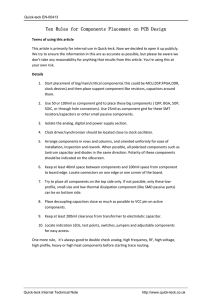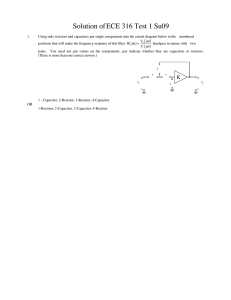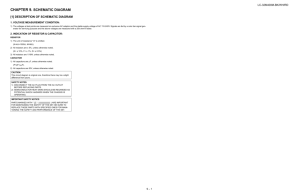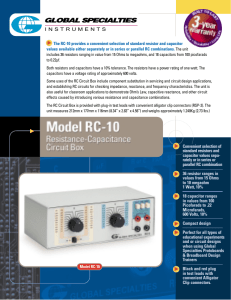reading part values
advertisement
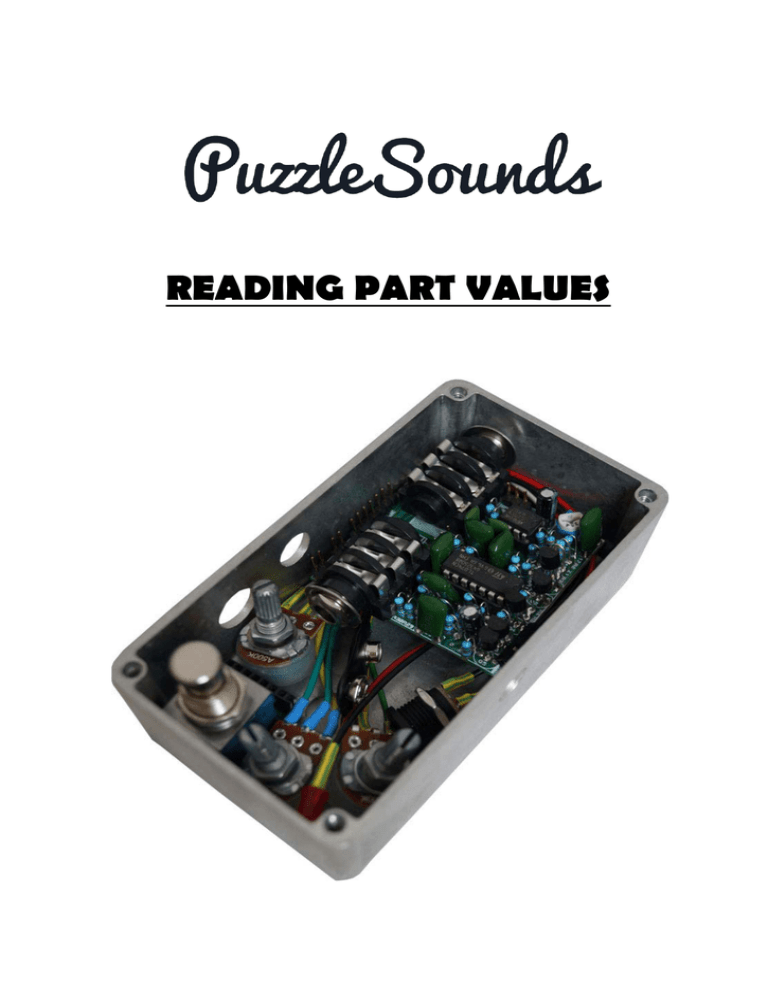
READING PART VALUES READING PART VALUES This is a quick guide in order to be used as a reference when assembling kits. We have used the same parts we send with our kits, so it is easier for you to identify them and read their value. ----- RESISTORS Resistors are widely used in effect pedals. They provide a known resistance to the flow of electric current. Since they are small, printing their value on them would be difficult; instead, they are marked with colour band code. Depending on the resistor type, there are more or less bands. Two main types are used: metal film resistors and carbon film resistors. 1- CARBON FILM RESISTORS This resistors are brown coloured, and have 4 colour bands: three of them set the value, and the last one the tolerance (gold coloured). This is the equivalence between colours and numbers: To read the resistor value, place it so the gold coloured band is placed in the right, and then read the bands from left to right: - The first two colour bands give you the first two numbers of the resistor value. - The third is a multiplier, and gives the number of zeros to add to the first two numbers to get the final value. - The fourth is the tolerance. Example: - 1st Ring: yellow (4) 2nd Ring: violet (7) 3rd Ring: yellow (4) 4th Ring: gold (5%) Resistor value: (4 7) · 10^4 = 470000 = 470kOhm, with 5% tolerance 2- METAL FILM RESISTORS This ones are blue coloured, and have 1% tolerance. Determining their value is done by the same process than with carbon film, but metal film resistors have one more band: - The first three colour bands give you the first three numbers of the resistor value. - The fourth is a multiplier, and gives the number of zeros to add to the first three numbers to get the final value. - The fifth is the tolerance. Example: - 1st Ring: brown (1) - 2nd Ring: black (0) - 3rd Ring: black (0) - 4th Ring: red (2) - 5th Ring (tolerance): brown (1%) - Resistor value: (1 0 0) · 10^2 = 10000 = 10kOhm, with 1% tolerance CAPACITORS Capacitors are the most used elements in effect pedals among with resistors. There are three main types that are used, but they share a common marking system. Capacitors are measured in Farads (F), but as this is a very large unit, the capacitors normally have values between some picofarads and some milifarads. Unlike resistors, capacitors are marked with numbers related to their value, but reading the value is not direct neither. By default, the capacitors are measured in picoFarads, and the last code number sets the number of zeros to add to get the real value. We will see this for every capacitor case. . Unit conversion: The capacitor value can be defined with different units, that relate between each other as follows: 1 miliFarad (mF) 1000 microFarads (μF or uF) 1 microFarad (μF or uF) 1000 nanoFarads (nF) 1 nanoFarad (nF) 1000 picoFarads (pF) . 1- CERAMIC CAPACITORS The ceramic capacitors are lentil shaped, and orange/brown coloured. Their value is often between some picofarads and some microfarads. There are two possibilities: Example: - The capacitor has two numbers engraved: in that case, the two numbers are directly the capacitor value in picoFarads. Marking: 22 = 22 pF. - The capacitor has three numbers engraved: in that case, the two first numbers are the value, and the last one the number of zeros to add (the value obtained is in picoFarads and may have to be converted to larger units to be easily used). Marking: 104 = 10 · (10^4) = 100000 pF = 100 nF = 0.1 μF 2- POLYESTER CAPACITORS These ones are better than ceramic and electrolytic, but their value is limited between some nanoFarads and some microFarads. They follow the same marking than ceramic capacitors with three numbers: the first two are the value, and the third one the number of zeros to add (the value obtained is in picoFarads, and usually has to be converted to larger units to be easily used). Perhaps the capacitor has some other numbers or letters written on it; the important ones are the three numbers that are consecutive. Example: Marking: 2A104J = 10 · 10^4 = 100000 pF = 100 nF = 0.1μF 3- ELECTROLYTIC CAPACITORS While their characteristics are not as good as ceramic or polyester capacitors, they are the only available solution when very large values are required. They can go up to some farads, but for audio they are usually around some microFarads. Their reading is direct, as they are larger and the value can be printed on them. Example: Marking: 100 μF
